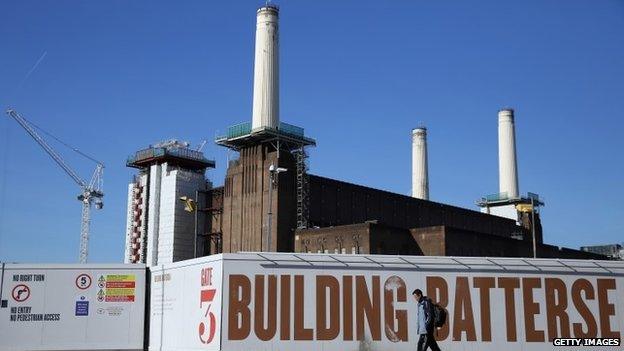Water 'could warm a million homes in England'
- Published

Water pipes had to be laid to extract the water from the sea and transport it to the heat exchanger
A million properties across England could in future be heated by water from rivers, canals and the sea, the government says.
The Department for Energy calculates this is the potential of a technology known as the water source heat pump.
This relies on a heat exchanger, which uses a system akin to refrigeration to amplify warmth from pipes in the sea.
If the energy from the process comes from renewables, properties can be warmed with near-zero carbon emissions.
Renewable heat
The government’s water source heat map, external identifies more than six gigawatts of potential low-carbon heat.
One major project – at the National Trust’s historic Plas Newydd house in Anglesey – is already running.
Roger Harrabin reports: ''It is the sea that is going to heat this house''
Launching the new map at Battersea Power Station in London today, Energy and Climate Change Secretary Ed Davey said: “We need to make the most of the vast amount of clean, renewable heat that lays unused in our rivers, lakes and seas.
“Doing this will help contribute to an energy mix that maximises clean, reliable home-grown resources rather than relying on foreign fossil fuels.”

Battersea Power Station developers are looking into installing a heat pump
Battersea Power Station is the latest developer to announce it will be looking into installing a heat pump.
Richard Parry, chief executive of the Canal and River Trust, the charity that cares for 2,000 miles of waterways in England and Wales, said: “This recognises the huge potential of water-sourced heat pumps to deliver a low carbon solution to the UK’s heating and cooling demands.
Heat pump
“We have a number of innovative projects on our canals and rivers.
"These are delivering benefits for waterside businesses and the environment and proving again that, 200 years after they were built, the waterways are still bringing a whole range of benefits to the nation.”
The heat pump system works best in well-insulated buildings because there is a large energy cost in warming the water to the level normally used in central heating radiators.
In the case of Plas Newydd it is ideal because the Trust doesn’t want the house to get too hot.
The 300kW marine source heat pump cost the Trust £600,000 and is expected to save around £40,000 a year in operating costs.
At Plas Newyydd, pipes have been laid into the Menai Straits, the narrow stretch of water which separates the island of Anglesey from mainland Wales.
The pipes are filled with a refrigerant heat transport chemical. The fluid extracts heat from the sea and releases it into the heat pump.
The fluid is compressed to increase the temperature further to heat the property. The pressure of the fluid is then lowered via an expansion valve and the process starts again.
A National Heat Map will be published at the end of June,, external showing the rivers in England that have the highest potential for water source heat pumps.
The map refers only to England, but DECC is in discussions with Scotland, Wales and Northern Ireland on the issue.
Follow Roger on Twitter @rharrabin, external
- Published22 May 2014
